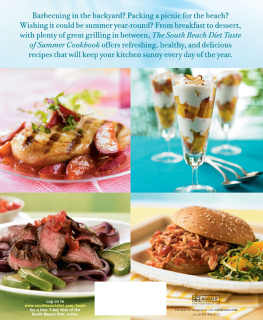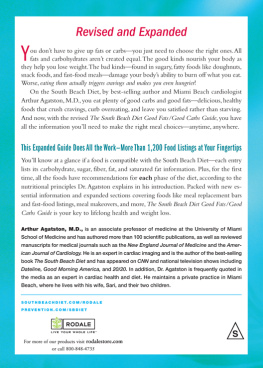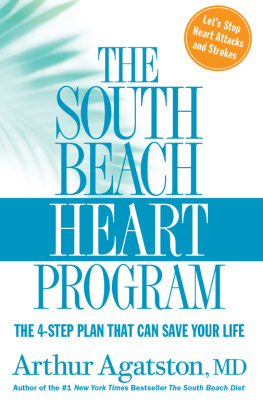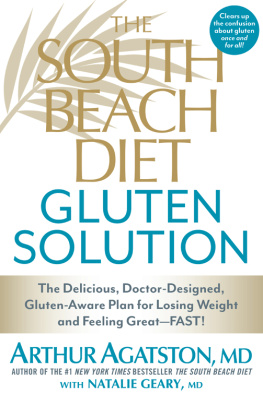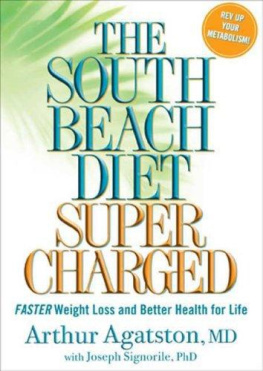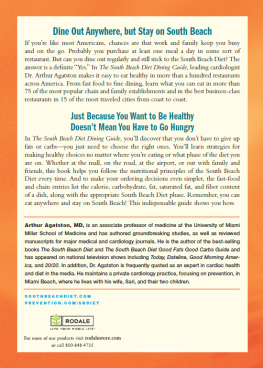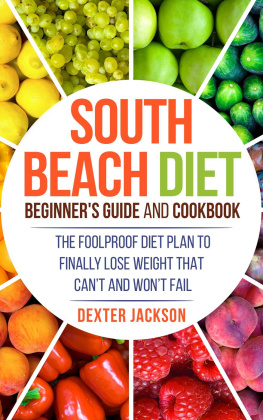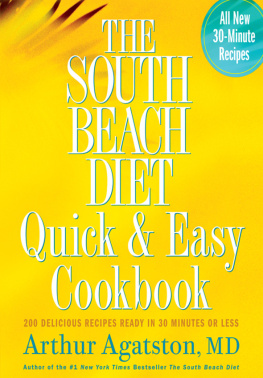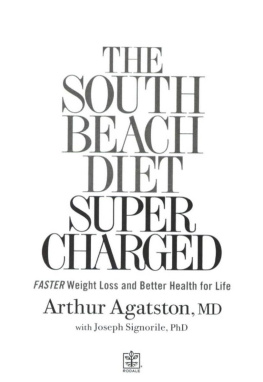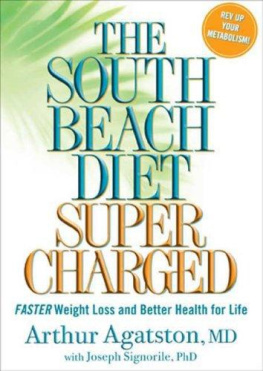


CONTENTS
To my wife, Sari,
and sons, Evan and Adam
ACKNOWLEDGMENTS
Many people have helped to produce this refreshing addition to our library of South Beach Diet cookbooks. At Rodale, I would like to thank Liz Perl, Margot Schupf, and Cindy Ratzlaff for their continued support, as well as my incredible editor, Marya Dalrymple, whose fondness for grilling inspired a number of the recipes in this book.
I would also like to thank art director Carol Angstadt and photographer Mitch Mandel for their creative vision, and project editor Nancy N. Bailey, test kitchen director JoAnn Brader, food stylist Diane Simone Vezza, and prop stylist Francine Matalon-Degni for their many hours of work on the book.
In addition, my appreciation goes to Mindy Fox for overseeing the creation and development of the recipes, and to Marie Almon, my nutrition director, for her guidance.
I am also grateful to Margo Lowry of the South Beach Diet partnership for her advice, and to my publicists, Alice McGillion and Lori Ferme of Rubenstein Communications, for their energy.
And, of course, no summer meal would be as enjoyable without my wife, Sari, and my sons, Evan and Adam, to share it with. As always, I thank Sari for her great taste and keen editorial eye.
FOREWORD
I love summer. The days are bright and long, with sundown arriving well into evening. Work schedules are generally more relaxed, school is out, and vacations are just around the corner.
In Miami Beach, where I practice medicine and live with my family, summers are hot and humid with lots of brief showers. But the days are also gloriously quiet and calm, since most tourists come to South Florida out of season. Many summers we travel as a family, perhaps taking some time away in a cooler climate. But we are always happy to come home to a relaxed, less-congested, balmy Miami Beach. For us, this is a time to invite friends over for casual grilled lunches and dinners next to the pool; a time to walk the relatively empty beaches; a time to play lots of golf, cheer for the Marlins, and enjoy other outdoor activities as a family.
During summer, I often find myself thinking just how perfectly the season captures the South Beach Diet lifestyle. Garden-and market-fresh ingredients are more available than ever. And with very little effort, they turn into bountiful salads dressed in healthy olive-oil vinaigrettes, refreshing chilled fruit or vegetable soups, and lively spice-rubbed grilled meat, poultry, and fish dishesthe very foods that, for us, are the perfect antidote to the sultry South Florida heat.
Summer is also the best time to reap the maximum health benefits of fruits and vegetables at their peak. Freshly harvested, these nutritious foods are particularly high in phytochemicalsplant-based micronutrients that act in numerous ways, including as antioxidants, to protect your health. Perhaps youve heard of lycopene, a member of the carotenoid family; its found in tomatoes, papaya, and other fruits. Or anthocyanins, which exist in blueberries, cherries, purple grapes, plums, eggplant, and more. Or lutein, which is present in spinach and other dark leafy greens. Or polyphenols, which show up in garlic and onions and, yes, in red wine, green tea, and dark chocolate, too. These are just some of the thousands of phytochemicals that help to fight all kinds of diseases and disorders, including cancer and high blood pressure. For more information on the nutritional benefits of these and other foods, turn to the glossary, starting on .
The point is, when you eat a wide variety of nutritious whole fruits and vegetables (in addition to whole grains, good fats, lean protein, and low-fat dairy), you not only improve your health but also get the greatest enjoyment from the South Beach Diet lifestyle. In fact, Ive often found that the people who are most successful on the South Beach Diet are those who make a conscious effort to try new recipes and take advantage of as many food choices as possible.
As youll see by browsing through this book, there are loads of possibilities for summertime eating. If youre a fan of burgers and hot dogs, like I am, youll find plenty of healthy variations on these popular foods. If you like lighter fare, weve got delicious soup and salad suggestions. And, of course, no summer day would be complete without a refreshing drink (try my favorite, Iced Pom-Mojito Spritzers, !).
But as Ive said so many times before, the foundation for truly healthy living is more than just a sound diet. Exercise is an essential component. And what better time than summer to get outside and get moving? When you combine the principles of healthy eating with a regular exercise program, you are employing the most powerful approach to shedding unwanted pounds, maintaining a healthy weight, and improving your overall wellbeing, while avoiding a host of health-related problems. On the next page, I give you some tips on walking, which I consider to be the ideal summertime exercise for people of all ages. Just put on some sunscreen, walk out your door, and go!
Living in Miami Beach, where cool, fresh foods and outdoor exercise are a way of life, my family has the pleasure of enjoying summer year-round. Now you can experience the fresh tastes of the season, just as we do, by preparing and serving the delicious, healthy recipes in this book.
A RTHUR A GATSTON , MD
Walking: The Perfect Summertime Exercise
Summer is a great time to cook, dine, and exercise outdoors! While any form of aerobic exercise (like swimming, hiking, or playing tennis or even softball) is excellent, walking at a brisk pace for 30 minutes a day is one of the best, and the easiest, exercises to do on a regular basiswhatever your age or ability. You can walk wherever summer takes you, whether its on the beach, through the woods, around the block, or even around the mall on a rainy day. When time is tight, park your car farther from the office, market, or shopping center. Walking here and there for 5 to 10 minutes will quickly add up to 30 minutes. Before you get started, here are some considerations:
Build a gradual routine. Consult with your doctor before beginning any new form of exercise. Step up your walking routine gradually, over a week or two, working up to 30 minutes as you get more fit.
Walk at a brisk pace. Consider a scale of 1 to 10, with 1 being the absolute slowest speed you can walk and 10 being the fastest you can walk without losing your breath. A brisk walk falls into the 6 to 7 range (later, as you gradually improve, you can move into the 8 to 10 range). If you can carry on a conversation at your fastest pace, youre in good shape. If not, take it down a notch. Begin and end your walk with 5 minutes at the 3 to 4 pace, and walk at your top pace for the 20 minutes in between. Breathe normally during the walk, and take a few deep breaths before stopping.
Practice good form and posture. Walk from heel to toe, pushing off from the toes with each step. Keep your chest lifted, your abdominals consciously drawn in, and your chin parallel to the ground. You should feel an invigorating, lengthening sensation as you walk.
Add resistance exercises. For a well-rounded workout, incorporate 15 minutes of stretching and strength-enhancing resistance exercises into your exercise program at least three times a week. This will keep your muscles and joints in shape and free from injury. You may want to try Pilates, a method of body conditioning that is great for any age and fitness level.
Next page
